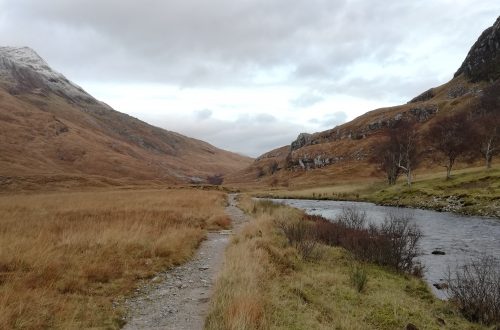
Compass Corner: Lesson 6 – How to Use Compass Bearings
Welcome to the first lesson in the second part of the Compass Corner navigation series! The next five lessons will focus on intermediate navigation skills. During these lessons, we will cover subjects like; using time and distance as navigation aids, contour interpretation and contouring, as well as using the landscape to aid us with navigation. This includes how to handrail, aim off and choose catchment features. However, today’s lesson will answer the questions: how to use a compass bearing and what is magnetic variation? I covered the basics of compass use, and how to take a bearing, in the last lesson. Now, we will take a more in-depth look at compass bearings. Discuss what is the magnetic variation (and what we need to know about it), as well as troubleshoot the most common mistakes when using compass bearings.
What is Magnetic Declination?
In short, there is a slight difference between the magnetic north, which the compass needle points to, and the true north, which is the line directly pointing to the geographic North Pole. Magnetic variation, also called declination, is the difference between the magnetic north and the true north in degrees.
As a further twist to this, the magnetic north moves over time. The amount by which the magnetic north moves over a certain time is known as the variation. The terms declination and variation have become used somewhat interchangeably, especially in the UK. For readers from elsewhere in the world, please check what the current magnetic variation is for your country, as the differences are huge!
The good news is that in the UK at the moment (in early 2021) the magnetic variation is very small. It is less than 1 degree in many parts of the country. This means that the difference is so small that it does not affect most normal navigational tasks. And so you can most of the time just ignore it!
How to apply magnetic variation?
However, what if you are in a location where the magnetic declination matters? This is how you can account for magnetic variation when navigating:
Firstly, if the magnetic north is west of the true north (360°), then the magnetic variation is negative. Whereas, if the magnetic north is east of the true north, then the magnetic variation is positive. As mentioned in the last blog post, declination needs to be adjusted when navigating using compass bearing. If you need to recap how to take a bearing, have a look back at last week’s lesson.
In order to adjust for magnetic variation, first proceed with taking a bearing like usual. However, after lining up the compass on the map and rotating the bezel to match the orienting lines with the vertical grid lines, add the extra step of adjusting for magnetic variation. For magnetic variations east of the true north, which are positive, the value is added to the bearing. And for those west of true north, which are negative, the value is subtracted from the bearing.
For example:
If you have a bearing of 100° with a variation of 5°East, the adjusted bearing would be 100+5 = 105°.
If you have a bearing of 100° with a variation of 5°West, the adjusted bearing would be 100-5 = 95°
As the current UK variations are so small, you can largely ignore making any adjustments. Only in situations, where navigation relying entirely on bearings is needed for extended period of time, the variation adds up to a meaningful difference.
When to use compass bearings?
Before tackling the main question, it is important to understand in what kind of situations bearings are used for navigation. Use bearings to navigate between locations when, for any number of reasons, accurately navigating using a map alone is impossible. These reasons may include conditions such as whiteout, darkness, featureless landscape or wanting to find a certain feature. In the latter case, this might mean aiming for a ridge or a path, in situations where it can be confused with other similar features or where missing it would be dangerous.
For example, you have reached the summit cairn of a mountain, and it is starting to get dark. You know that descending a couple of hundred meters of a ridge will get you onto a path leading down. However, there are also two other ridge lines starting from the summit. It can be useful to take your map out and check the bearing between the summit (your known location) and the ridge you want to descend. Taking a bearing is a useful way to make sure that you start descending the right ridge. You can then, with peace of mind, start making your way down knowing that you will reach the path quickly.
What are the Most Common Mistakes When Using Compass Bearings?
Many mistakes when taking a compass bearing are caused by either, carelessness, inexperience or fatigue. However, by being diligent and always following the same steps, you can eliminate many of the potential pitfalls. The problem with making mistakes when taking a bearing is that small errors often result in you being 180 degrees out. And therefore, ending in the opposite direction to where you wanted to go! These are the most common mistakes when taking a bearing:
- Holding your compass backwards on the map with the direction of travel arrow not pointing to where you are going.
- Not pointing the orienting arrow towards the map north (the top of the map).
- Using the south (white) end of the magnetic needle, instead of the red end, which points towards north.
- Not holding your compass flat. Holding your compass tilted can cause errors as the needle does not float freely.
- Having a broken compass. Forgetting to store your compass away from metallic and magnetic items, including mobile phones. As long-term exposure to these can reverse the polarity of the compass needle.
- Accidentally rotating the bezel as you remove the compass from the map. Small inaccuracies can result in big errors. Accidentally nudging the bezel by just a few degrees will cause you to be off your course.
How to troubleshoot for mistakes while navigating?
In a nutshell, troubleshooting for navigation errors comes down to proactively and frequently checking that you are on the right course. It is much easier to correct mistakes, if they are caught early! Once you are already lost, relocating becomes a much bigger issue. Therefore, it is important to at all times know what is around you and know what you are expecting to see next. If at any point, the expectation you have does not match with the reality in front of your eyes, this warrants for taking the map out and checking the situation!
More in the Compass Corner Series:
Check out the Compass Corner Navigation Lessons Syllabus for the first part of the series on navigation skills for beginners.
And, sing up now for more outdoor content by following Hill Days on Instagram and Pinterest!





